This post may contain affiliate links. Please read our disclosure policy.
Make your own chickpea tempeh from scratch with just 3 ingredients! This soy-free tempeh is high in protein and can be used in stir-fries, soups, sandwiches, and more!
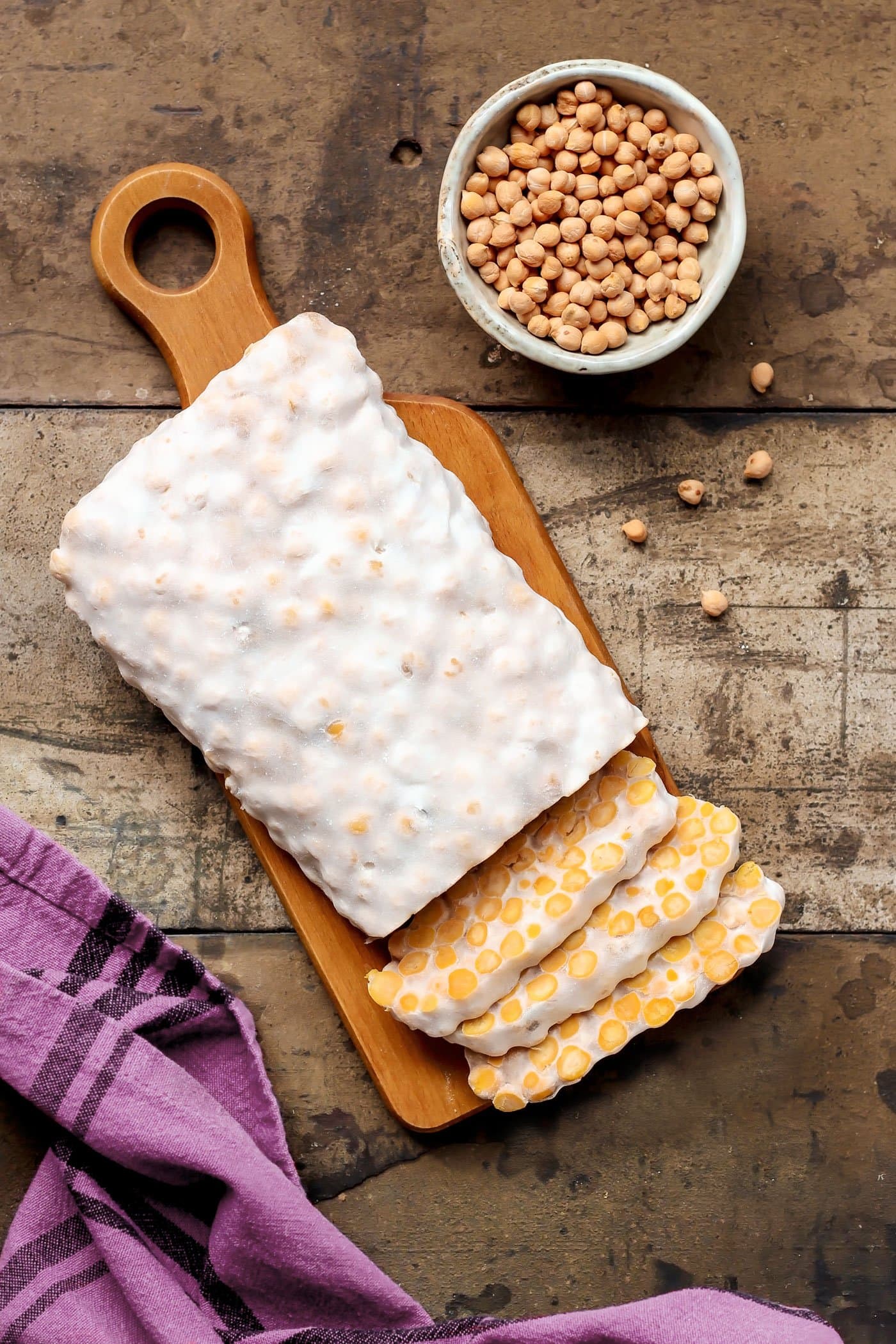
Do I have a thing for fermented foods? Probably.
I recently discovered chickpea tempeh and loved it even more than regular soy tempeh. It has a slightly different texture. It’s a bit softer but has no bitter aftertaste at all like regular ones have! The thing is, it’s not as widely available and, most of the time is more expensive. After a quick search on how to make basic tempeh, I tried to adapt it for chickpeas, and it worked!
Not only is it completely soy-free, but it is also delicious and a lot easier to make than you may think! Get ready for A LOT of step-by-step photos!
📘 What is Tempeh?
Let’s start from the beginning. What is it exactly? Tempeh is a traditional Indonesian fermented food. It is made by cooking soybeans and fermenting them with a mold called Rhizopus Oryzae for 24-48H. Once the fermentation is done, all the soybeans are bound together into a compact cake by a white mold. It then becomes sliceable and ready to cook.
🥬 Health Benefits
Since tempeh is a fermented food, it is very rich in probiotics, which aid in digestion and improve overall health. Tempeh is also:
- Rich in protein: Even if chickpeas have less protein than soybeans, they still contain 15g per cup, which makes them a great meat replacement.
- High in fiber: In addition to being protein-packed, chickpeas are also rich in soluble fiber and increase satiety.
- A whole food: tempeh is less processed than tofu since you consume whole beans. Tofu is made from soymilk, where the ground beans are discarded. So even if tofu is a healthy food, tempeh is often considered healthier and packs more nutrients.
🥣 How to Make Chickpea Tempeh
Making chickpea tempeh requires only 3 ingredients (and some patience):
- Dry chickpeas
- White vinegar
- Tempeh starter
It all starts by soaking the chickpeas overnight. When I did my first tests, I went with large garbanzo beans, but due to their size, the white mold had trouble growing, especially on the inside, because of too much empty space between the chickpeas. It results in a tempeh that is not super compact and crumbles very easily. So I recommend using the smallest chickpeas you can find, or read the note at the end of the recipe if you plan to use garbanzo beans. I guess split chickpeas will work, too. Just reduce the cooking time.
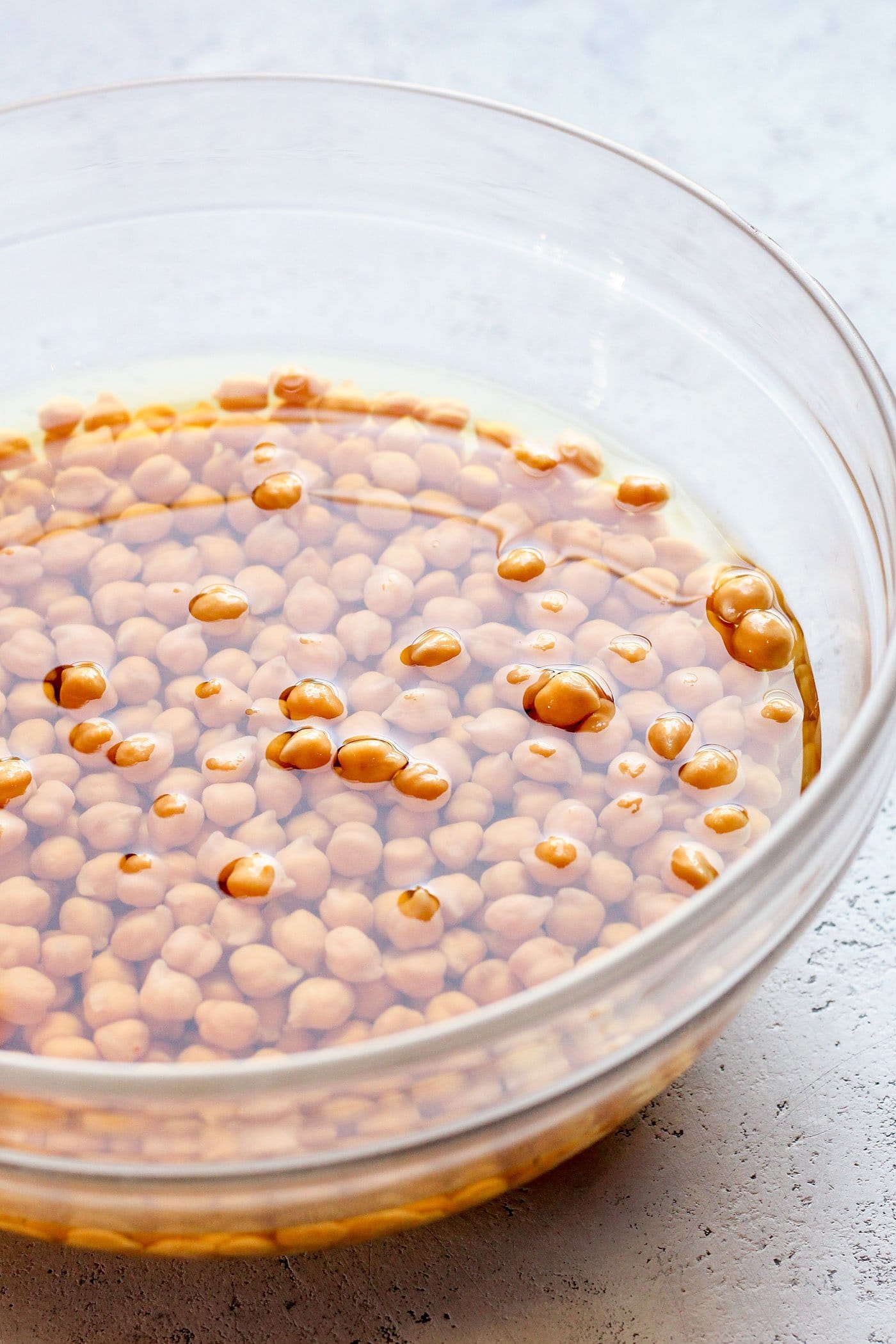
The next step is to drain and rinse the chickpeas, transfer them to a large pot, cover with water, and cook from 1 to 1H30, or until they are soft but still keep their shape well. You don’t want undercooked or mushy chickpeas!
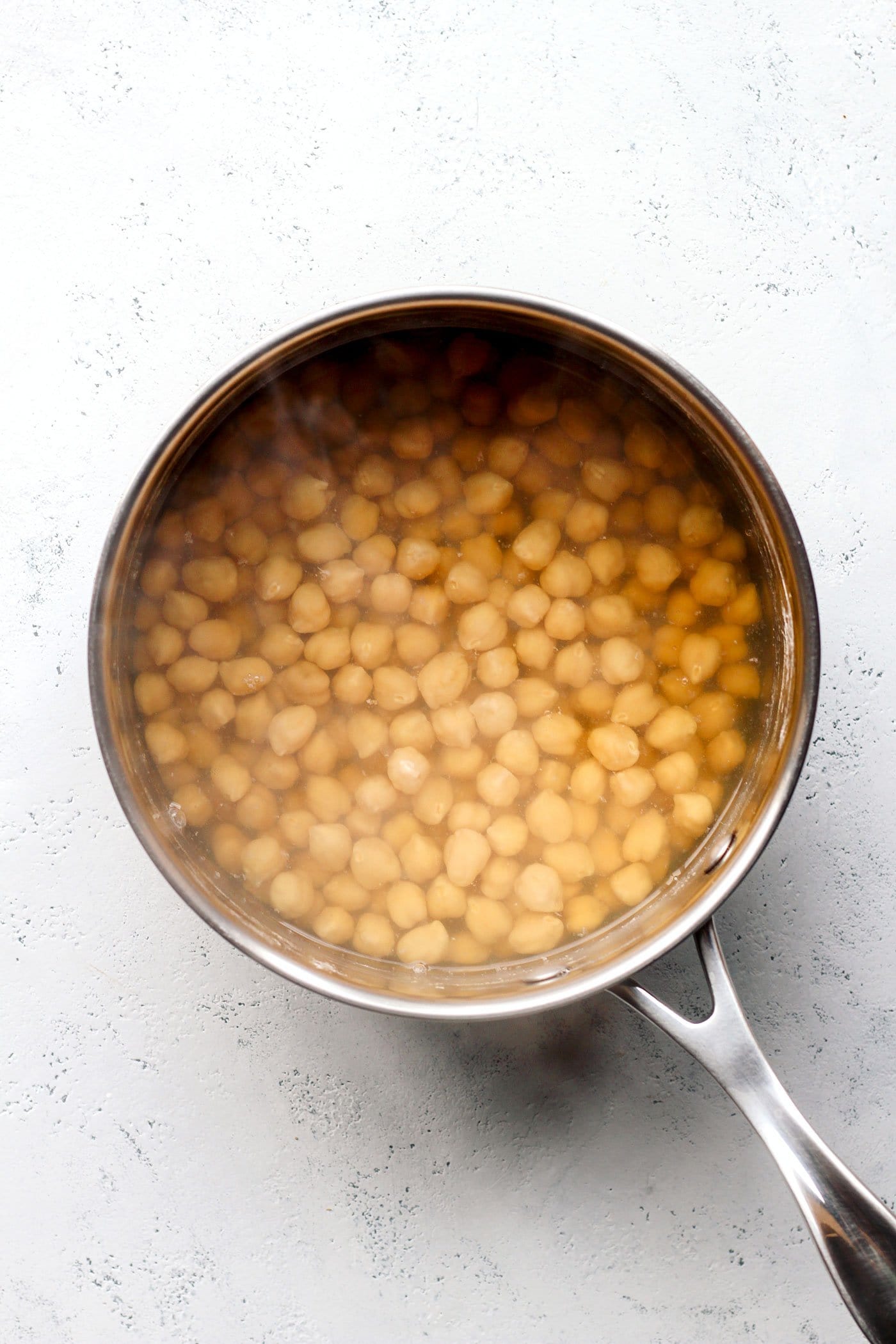
Once your chickpeas are perfectly cooked, you will have to let them drain for 30 minutes. For optimal growth of the mold, the chickpeas must not be too moist.
After 30 minutes, if they are still a bit moist, use a paper towel to absorb excess water. Transfer the cooked chickpeas to a large bowl, stir in the white vinegar, and mix until well distributed. The vinegar will help stop the development of possible bad molds or bacteria.
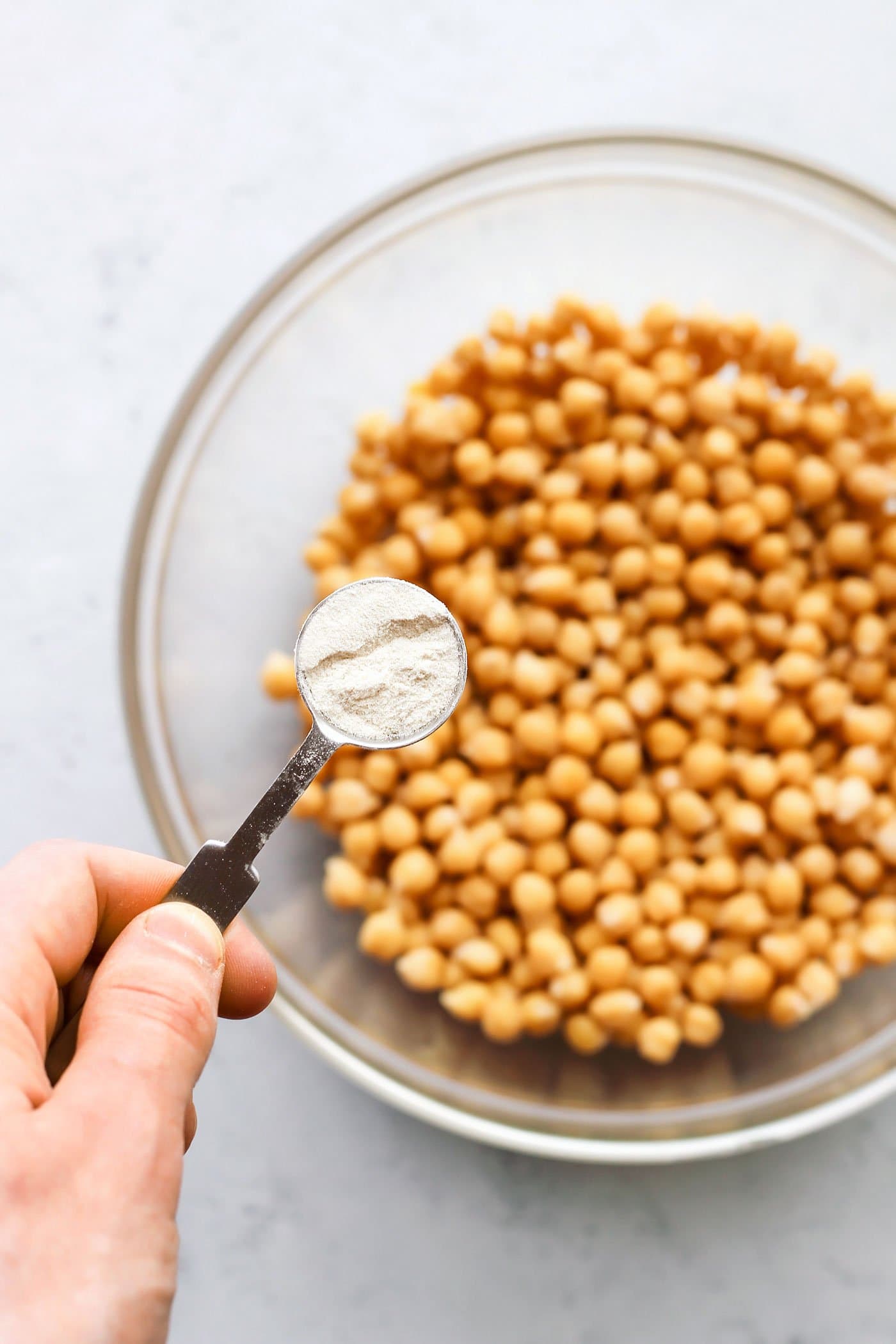
The last step is to stir in the tempeh starter and mix well to ensure it is uniformly distributed. Once this is done, you transfer them to a transparent plastic bag. I used a freezer bag, but any food-safe plastic bag would work. It’s important to perforate the plastic bag with a skewer (or a chopstick) to allow for air circulation. Otherwise, the mold won’t grow. Alternatively, you can use a perforated plastic container or Tupperware.
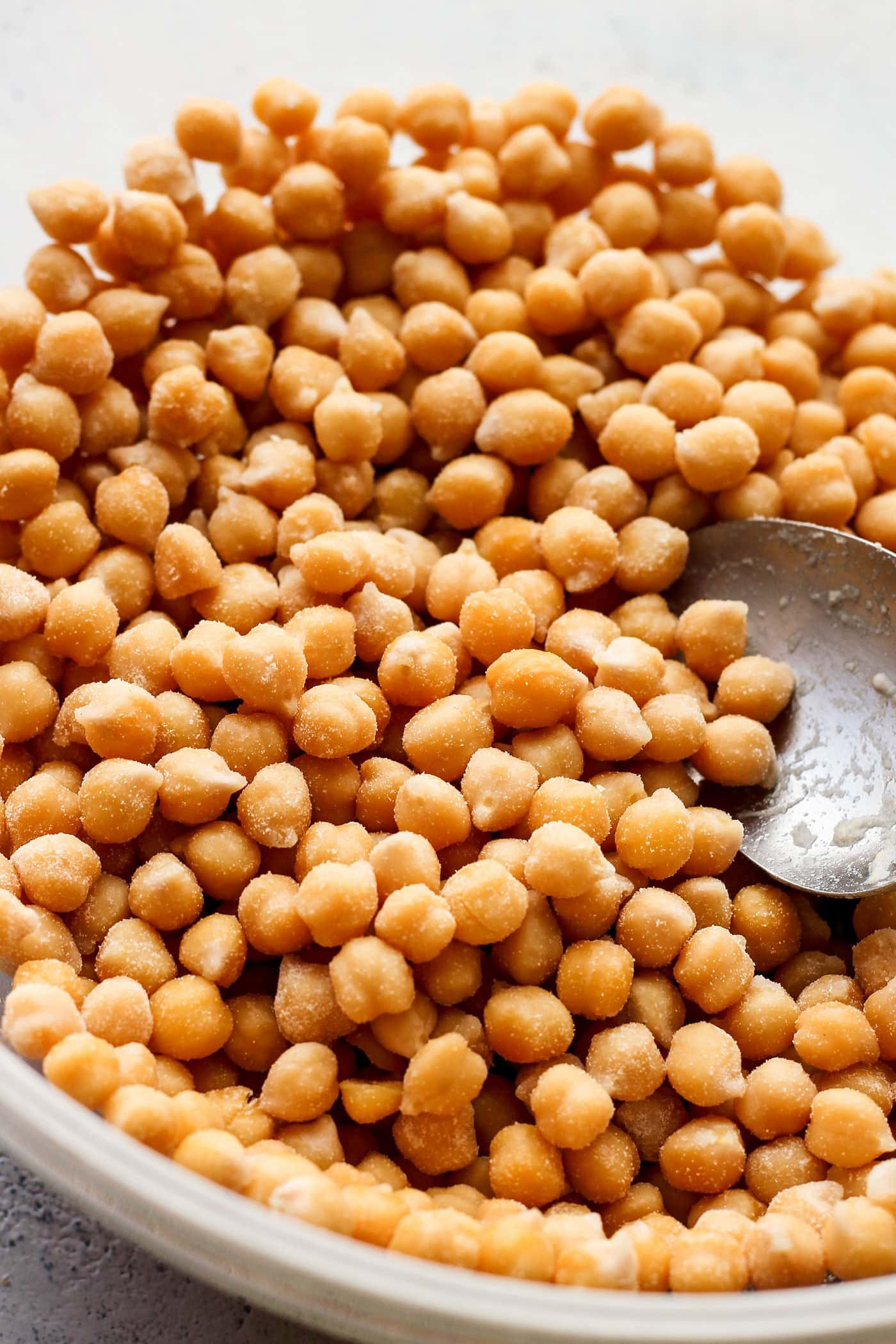
You must pack the chickpeas well and press them flat so the thickness is about 1 inch. Then, place the bag on a baking sheet and put it in the oven for about 12-14 hours at 86°F (30°C). My oven can go to low temperatures, but if yours don’t, then just let the oven light on, or use a dehydrator.
I read some people had success by putting a lightbulb in a container, but in my opinion, the oven is an easier option.
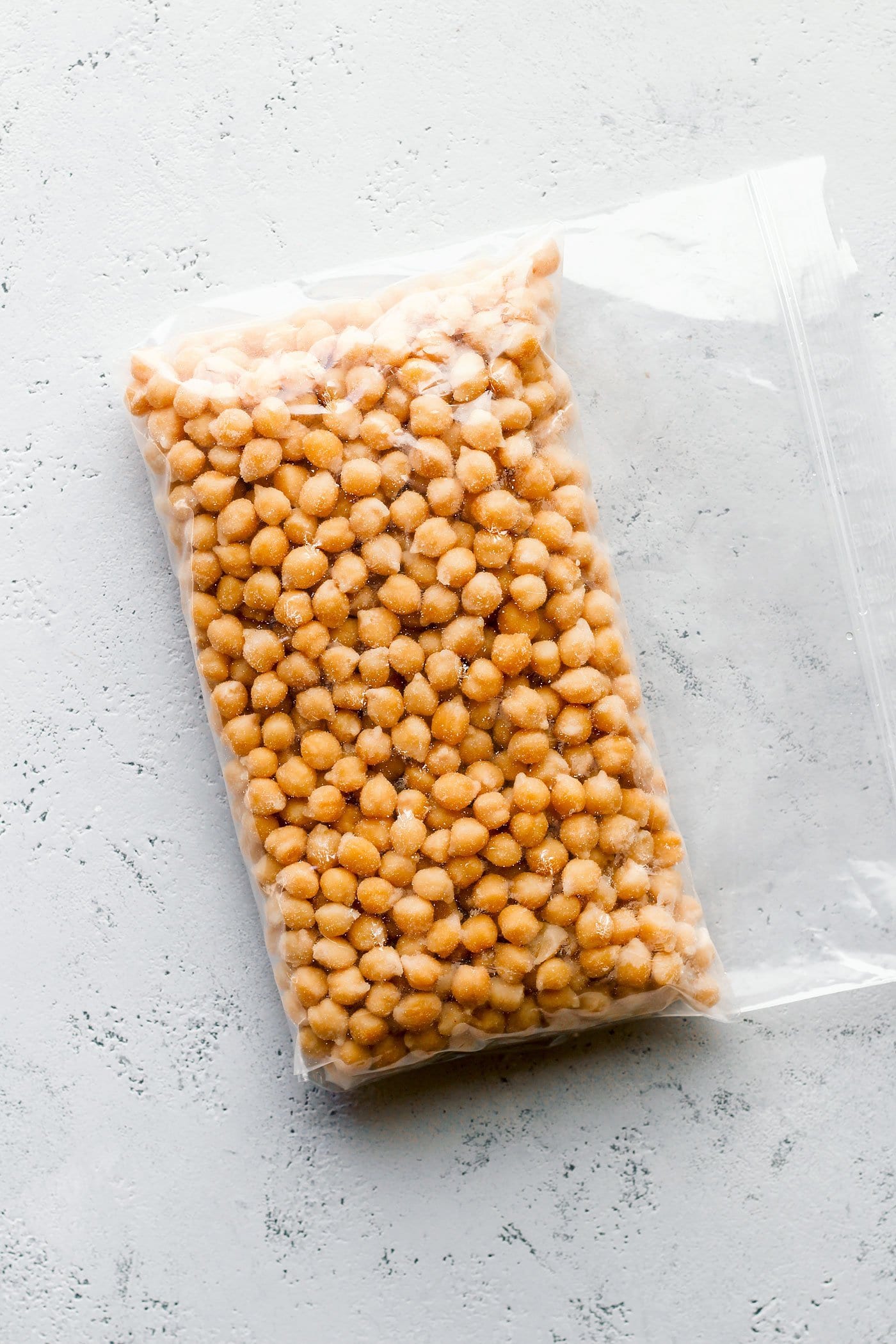
After 12-14 hours, you should start to see some white mold growing on the chickpeas. At this time, you can remove it from the oven and let ferment for another 24 hours in a dark and warm place. It can take up to 48 hours in total for the chickpeas to be coated with white mold.
When the tempeh is fully coated and forms a cake, it is ready to use! Just wrap it in plastic film and store it in the fridge. It will keep for up to a week in the fridge.
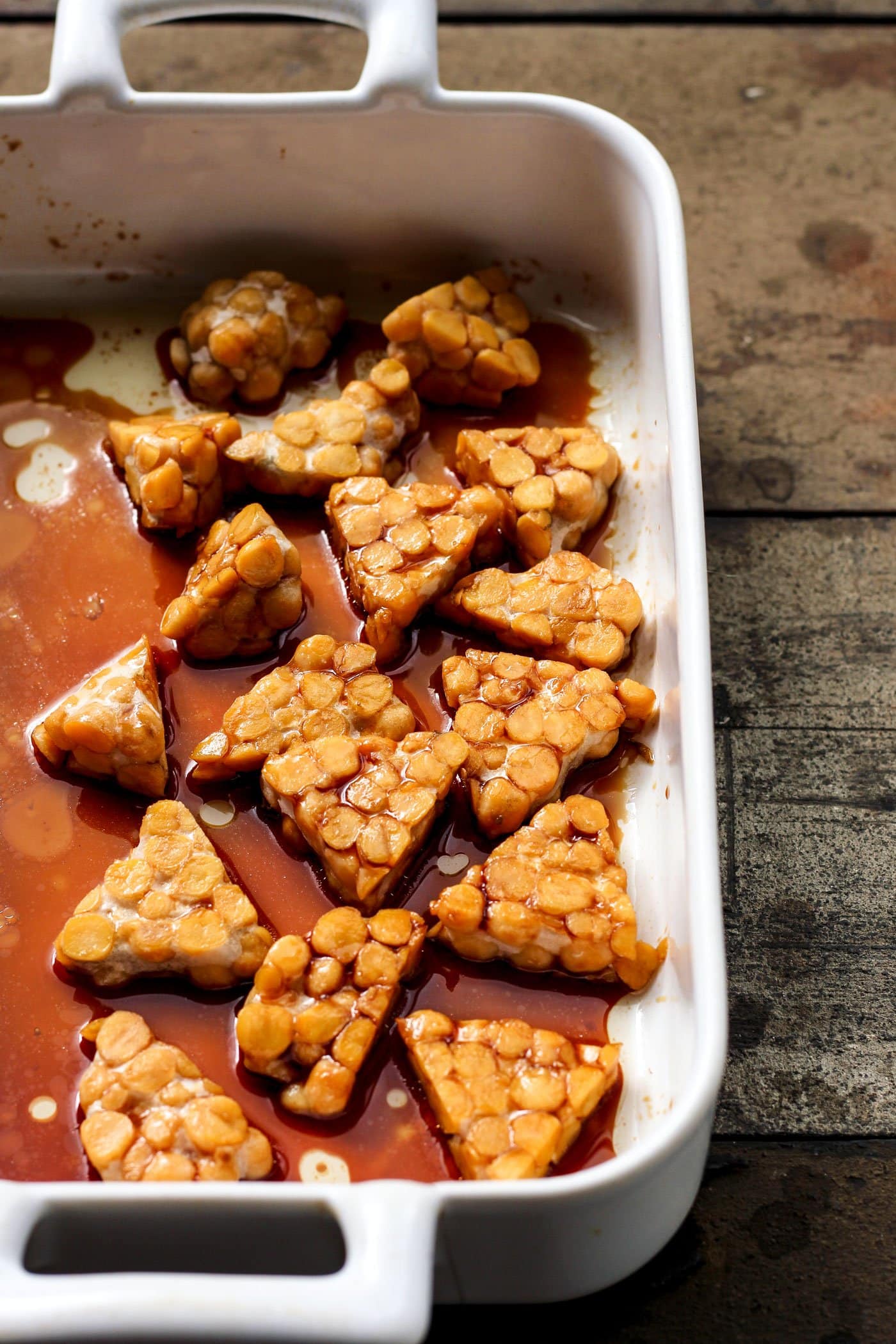
🌯 How To Use it?
Just like soy tempeh! If you want a milder taste and firmer texture, I recommend steaming it for 20 minutes before using it in recipes. This is not mandatory, though. Here is how you can cook tempeh:
- Marinade: Marinating tempeh slices is the best way to add flavor. A simple and tasty marinade is one part sesame oil, one part maple syrup, two parts soy sauce, chopped garlic, and your favorite herbs or spices. Marinade at least 2 hours before baking or shallow frying. For something fresh, check out my Marinated Tempeh Salad recipe.
- Bake: Marinated or plain tempeh can be baked for about 20 minutes at 350°F. The longer you bake it, the firmer and dryer it will get.
- Fry: Tempeh fries beautifully. It becomes crispy on the outside and remains soft on the inside. Frying obviously adds some calories but makes very tasty tempeh.
Tempeh is so versatile. It can be used in salads, burgers, sandwiches, curries, scrambles, and a lot more!
I hope this guide will give you the desire to make your own tempeh. It’s a fun and easy process. Homemade tempeh is delicious and can be used in a lot of recipes!
Let me know in the comments if you try this recipe!
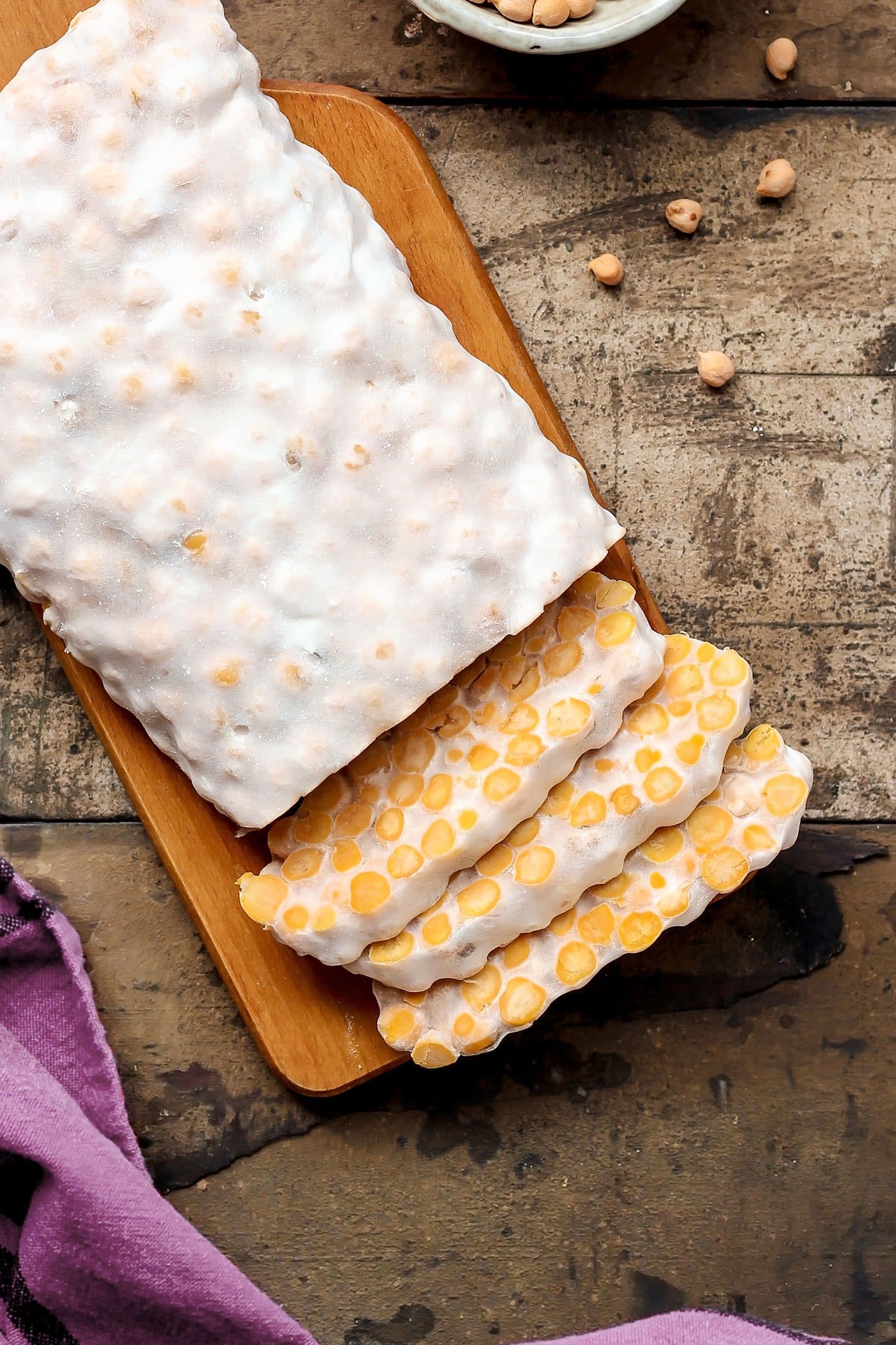

Save this recipe!
Enter your email below and I’ll send it to your inbox!
Plus, you will receive new recipes every week!
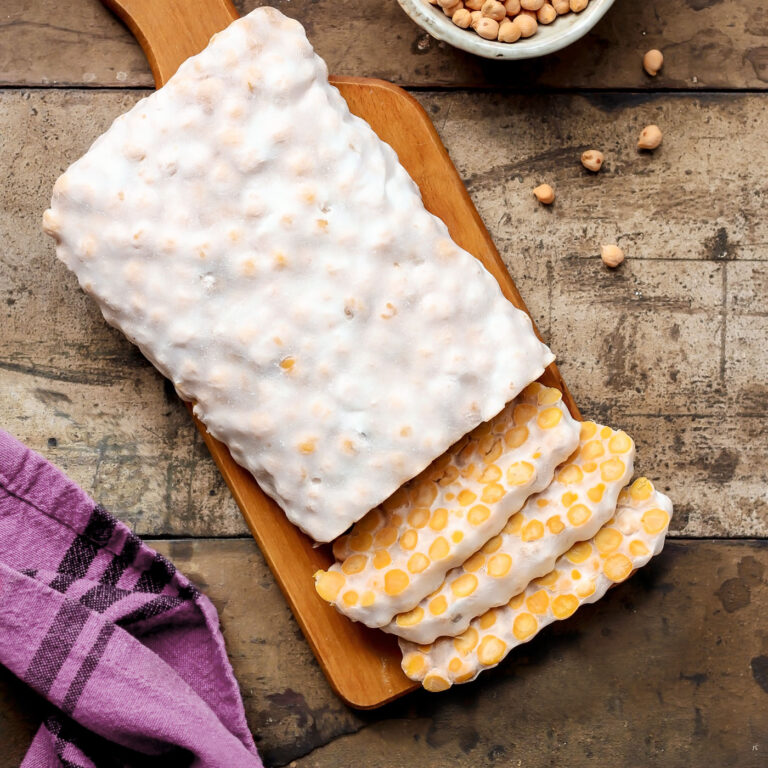
How To Make Chickpea Tempeh
Ingredients
- 1 cup dry small chickpeas
- 1 tbsp white vinegar I used white rice vinegar
- 1 tsp tempeh starter
Instructions
- Place the chickpeas in a large bowl, cover with clean water and soak overnight.
- The next day, drain and rinse the chickpeas. Transfer to a large cooking pot, cover with water (about 2-inch higher than the chickpeas). Bring to a boil and let simmer for 1 hour. Depending on the size of your chickpeas it might take up to 1 and 1/2 hour. They must be soft but not mushy. If some foam forms on the surface during cooking, remove it with a spoon to prevent any spillover.
- Once the chickpeas are cooked, drain them and leave them in the strainer for 30 minutes. After that, pat them dry using a paper towel to make sure they are mostly dry on the outside.
- Transfer to a large clean bowl. Add the white vinegar and stir to coat. Add the tempeh starter and mix well using a spoon until uniformly distributed.
- Using a metal skewer, or chopstick, prick some holes (at about 2-inch intervals) in a clean freezer bag. This step is important to create good air circulation and allow the mold to grow.
- Transfer the chickpeas to the freezer bag and form a rectangle of about 5×8 inches with a thickness of about 1-inch. Place the bag of chickpeas on a baking sheet and put in an oven with the light on for about 14 hours. I set the temperature of my oven to 86°F and let the door very slightly opened because I can’t just let the light on.
- After 14 hours, some white mold (not a lot) should have appeared on the chickpeas. You might also see some condensation inside the plastic bag, this is normal. It’s time to remove the baking sheet from the oven and let it ferment for another 24-36H in a dark and warm place. I recommend covering the chickpea bag with a clean towel to make sure it’s not under direct sunlight.
- Your tempeh is ready when it is fully covered with white mold and forms a solid cake, which usually happens at the 48-hour mark. It can be quicker if the temperature in your house is high.
- Raw tempeh will keep for up to a week in the refrigerator. If you want to freeze it: steam the tempeh for 25 minutes, let cool completely and wrap in plastic film before freezing.
Notes
Nutrition

About the Author
Thomas Pagot is the founder, photographer, and recipe developer behind Full of Plants. He created the blog in 2016 as a personal cookbook for vegan recipes. Through years of recipe development, Thomas has successfully grown Full of Plants into a trusted resource for plant-based recipes.

Leave a Comment
Have you ever used canned chick peas? If so, what were the results?
I have never tried using canned chickpeas, sorry!
Hi, do you de-hull the chickpeas? From what I read usually for other beans we need to dehull them before the fermentation. I’ve never cooked chickpeas so I’m not sure whether they have hull 😂
Hi Helen,
I didn’t de-hull the chickpeas, and it worked great!
I just made this recipe — the tempeh turned out a more grey than white. Is it still safe to eat?
Tempeh should be very light grey to white. If it’s really grey, I doubt it’s safe to eat.
Why can’t you just cook the chickpeas completely in the Instant Pot, like the soybeans, why do you have to soak them first? Also, why not crush them down, so there is less room between them?
You could, however it will take longer to cook.
Well, traditionally, tempeh HAS room between each bean, allowing the mold to grow and helping the beans hold together. You can slightly crush them, but you still need enough air holes inside to let the mold grow.
You are so wonderful! Can I use Garbanzo recipe in the instant pot too like your instant pot recipe
for soybean tempeh? Heard about you through Plant Pure Chef Our adorable best cook, KIM Campbell
Definitely! The incubation process is the same 🙂
Can you use your instant pot method withc chickpeas?
Yes!
Thank you for your great recipes. Can I use your instant pot recipe and substitute the soy beans with chickpeas or other legumes?
You’re welcome Jane!
Sure!
One of my favorite
ChickPea Tempeh is also great for making feta chess
Follow up comment, my tempeh didn’t have any bad smell but, was dark gray all over with large white spots, what is wrong? the temperature was 85-89 like I said before.
It’s very hard to say, try using perfectly clean tools/bag next time, and if it still happens maybe your starter has a problem.
Hi, chickpeas were very dry, , and turn hard, I add the vinegar and mixed
And the tempeh starter and mixed, I did every thing according. I used my oven with the pilot only,
The temperature was 87 -89
Thank you
Hi Mary, what do you mean “turn hard”, you should only let them “dry” for 30-40 minutes.
Hi Thomas, I tried this recipe twice, but it grew gray mold and it smelled really bad. Until I saw here in the comments, that it was possible to put it to ferment on banana leaves. I tried, and this time it worked. I am very happy for this, as I am using my oven for this. Thank you so much for your recipes.
Glad to hear you had success with your second try! Maybe your plastic bags had a problem.
After a bit of a performance I finally got this to work. I managed to kill my first try, as I blindly went for the “put it on the oven with the light on” part. Unfortunately, actual room temperature was already perfect for incubating the Tempeh (end of summer here… My kitchen is a happy 28 – 30 °C, and the oven, just with the light on, was reaching 35, which basically zapped the starter.
SOOO, I added another 1/4 teaspoon of starter to the mix, made more holes in the bag and 30 hours later (and with a lovely meat thermometer happily spiked well into the bag) I can now say that I have made my first block of Chickpea Tempeh.
This is the first of what I hope will be many many many that I make. And I am so excited to try other variations and more recipes.
Amazing site!
Awesome! So glad to hear you had success with it!
i made black chick peas tempe . mycellium is formed but the tempe is breaking. is it safe to consume ? there is no bad smell
I guess you didn’t let it incubate enough so there is not enough white mold to hold everything together. It’s still good to eat.
Hi. Thomas! I’m wondering if you’ve tried making this chickpea tempeh in an Instant Pot before, and if so, how the instructions would change for making it in an Instant Pot? I tried making this chickpea tempeh myself following your instructions for making black bean tempeh in an Instant Pot(just using chickpeas in place of the black beans) and my chickpea tempeh didn’t grow enough mold, etc. Would chickpeas need to be cooked longer in yogurt mode, or do chickpeas require a longer period of time in a pressure cooker after the yogurt mode time is complete?
Another question I have is: If I want to double a batch of black bean or chickpea tempeh (or any other variety, really), would I use double the amount of water called for in the Instant Pot directions for making black bean tempeh, or would I still just add one cup of water to the bottom of the Instant Pot?
Hi Holly,
I did, I always use my Instant Pot to make tempeh no matter if it’s with chickpeas, soybeans, or black beans. Yes you should follow my Instant Pot Tempeh recipe, regarding the incubation time it really depends and I found out it can vary. Take a look from time to time, once a good amount of mold has appeared you can usually turn the Instant Pot off as the tempeh generates its own heat.
If double, use the same amount of water. Just be aware that I didn’t always had great results by stacking tempeh loaves in the IP.
Thanks, Thomas. This really helps!
Hi. Should we end up with holes all over (and both sides) of the bags of tempeh, or should we only be puncturing the bag only in a single row, with holes spaced about an inch apart?
Hi Holly,
You should end up with holes on both sides of the bags.
Can the chickpeas be pureed to make the tempeh? I would prefer a more creamier tempeh and wondered if this can be made with pureed chickpeas?
I would not recommend it, if using mashed beans the mold might have trouble growing. It needs air to grow.
I used to eat tempeh, and even made my own from soybeans.
One day I ate too much fried tempeh (well-fried tempeh is absolutely delicious and reminds me of bacon) and got sick and couldn’t eat again. I believe this has a lot to do with the fat-content of soybeans, which is unusually high.
Then a day ago I had an idea why not try chickpeas, and now it seems its a common enough thing. You site came up first on Google, so there you go.
I probably won’t use tempeh culture starter, just grind up commercial (live) tempeh very fine and dry it out.
you saud dont ovwrcook tge beans till mushy. juat curious what happens if you cook the beans to much and they are mushy or really broken up? how does this impact the tempah? thank you
That is correct, you don’t want the beans to be too mushy. I have never tried with overcooked beans so I cannot say.
Too mushy and the beans will mush together, even with holes poked through. The air won’t get through and you’ll get both tempeh-mold and other molds. It risks just getting a rotten mess that will have to be thrown out.
Good to know!
Love the taste, better than soy beans . Thank you for sharing!!
You’re welcome Rifa!
I’m excited to try to make chickpea tempeh. I plan to use this recipe instant pot style. Hope it turns out well
Would it work to sprout the beans prior to cooking?
This is a good question, I honestly have no idea.
How long would you recommend to cook the chickpeas in the instant pot?
I would recommend soaking overnight, and then pressure cook 5 minutes. Then let the pressure release naturally for another 20 minutes.
I made soybean tempeh successfully. I just tried making chickpea tempeh but only a bit of white mold formed and the rest of the beans turned gray/brown. It tastes funky. Should I try splitting the chickpeas in a blender before boiling them to create smaller more compact tempeh so that the mold spreads throughout?
Yes, that could be an idea. I haven’t tried but I think it should work!
I will be cooking garbanzo beans in Instant pot to help with lectin removal. Has anyone had expirience with how long to cook them?
Also is it OK to season prior to incubation? I was going to use onion granules, hickory salt & chipotle powder.
Is there a way to make this without plastic?
You may use banana leaves.
I have tried making tempeh twice now, but always have condensation forming even though I dry my beans well. Instead of throwing away the current batch, could I just add more vinegar and starter culture to the beans with new plastic bags and containers?
I’m afraid just adding more vinegar it won’t work…
Hi Thomas,
My chickpea tempeh turns out great, nicely packed and great mycelium growth but it has a very strong fermented taste that I find over powers any flavor i try to cook it with. Any suggestions? Ive read it could be to do with the vinegar and when this is added?
Thanks for your help.
Hi Brooke,
Have you tried to steam the tempeh for about 30 minutes?
Has anyone tried making lentil tempeh? On my 1st attempt now incubating french lentil, hemp seed & brown sesame seed tempeh in instant pot on yogurt less setting. I am nervous it won’t turn out.
Hi Thomas, I was thinking of making this in the instant pot (finally got one!!!). Do I just follow the soy instructions but replace with chickpeas? Also do you have to peel the chickpeas doesn’t seem to mention that you have to in this recipe.
Hi John, yes it will work with the instant pot recipe!
I usually don’t peel the chickpeas but if you prefer to do so, you can place them in a bowl of water and rub with your hands to remove most of the peels. Then drain on a clean kitchen towel.
This recipe sounds wonderful. I’ve never made anything like this before and our family is trying to reduce our use of plastic. Do you have any idea whether or not this could be made in a glass container? Thank you!!
Thanks Julia,
Humm…I’m not sure about the glass container honestly, I think the mold will stick to it and it will be difficult to remove the tempeh from the container. You may use banana leaves though.
do you mean use banana leaves inside a glass container?, we to are not into using plastic bags or plastic wrap
No I mean just place the beans in banana leaves and wrap it tightly, no need to use a glass container.
Hey
I have made it in a glass container and it was fine. Didn’t stick at all actually. I have limited to a max 1 inch high. Best results I had so far was covering with an aluminium foil with holes on it trying to keep it as tight as possible. I tried also covering with organic cotton cloth it was ok but less compact on the top because there was more air circulation vs aluminium foil.
Also tried doing it in cotton cloth(wrapping the whole thing) it was ok but not very compact compared to the above methods.
I want to try with silicone ziplock next
Why would the aluminium foil need to be really tight? (if there are holes in it, then the tightness serves no purpose).
The vinegar (and fermenting mold) risks attacking the aluminum and adding a mawkish off-taste of aluminum salts, which are also slightly toxic. The taste may not be noticed because tempeh’s own strong flavor, but you might not want to be consuming biologically active aluminum ions.
http://www.ncbi.nlm.nih.gov/pubmed/28752219